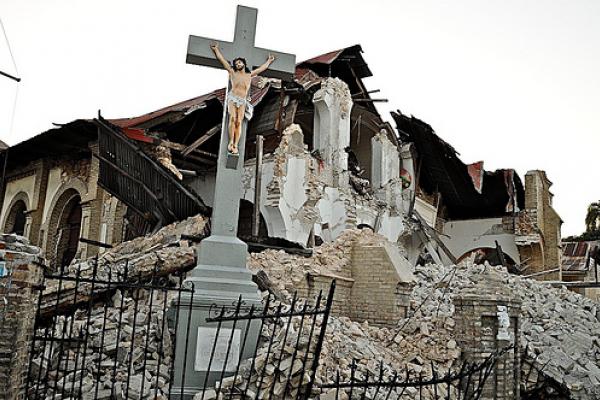Haiti will always be Haiti. It will never change. That's what a young, educated Haitian told me as our Land Cruiser meandered past the still-destroyed National Palace two years after a devastating earthquake struck. The young man said he had little hope for his country but would always have hope for himself and his family.
Multiple Haitians expressed this dualistic worldview to me during my recent five-day trip to Port-au-Prince on behalf of Mennonite Central Committee. For many, authentic hope is neither wishful thinking nor blind optimism. Hope, as theologian N.T. Wright says, "is a mode of knowing, a mode within which new things are possible, options are not shut down, new creation can happen."
The Haitian people I met have hope that new things are possible in their personal lives. As for the country they love, their outlook is more cynical — a result of unmet expectations. Despite steep adversity, the Haitian people remain resilient.
For generations, many Haitians have dreamt of securing their rights to life, liberty and the pursuit of happiness. They own the unfortunate label of poorest nation in the western hemisphere. They have suffered from and persevered through great injustices: French colonialism and slavery, international debt and short-sighted trade policies.
Haiti, a friend recently told me, is unfortunately known more for violence, insecurity and poverty than for its beauty, generosity, spiritual vitality, dancing, art and revolutionary heritage.
More than 200 years ago, Haiti burst the bars of French control to become the first black-led republic and first independent Caribbean state. As recently as the 1980s, Haiti was self-sufficient in rice production; Haitian rice farmers could make a living through farming. Today, rice imported from the U.S. is cheaper than Haitian rice.
More recently, though, tragedy struck again. On Jan. 12, 2010, a magnitude-7 earthquake crippled 250,000 residences and 30,000 commercial buildings. Though estimates vary greatly, about 220,000 people died. About 1.6 million people were left homeless. Hundreds of thousands more fled to other parts of the country, mainly to the Artibonite Valley.
Then along came cholera -- in that exact same region. The disease, which hadn't been documented in Haiti in more than a century, was discovered in October 2010 and reached Port-au-Prince a month later. Reports suggest more than 6,700 people have died. Thousands more deaths are likely.
Widespread disease can make the injustice of extreme poverty painfully clear. Cholera is treatable with oral rehydration therapy. This simple solution saves millions of children every year from death due to diarrhea, the second leading cause of death in children under 5.
Ongoing homelessness is also an issue. The number of people living in temporary housing and tent camps has dropped from 1.3 million to 600,000. Many have moved into repaired homes of family and friends, but many don't have any shelter at all now.
How does one dig out from under such tragedy? How does one have hope for a better life, for a new Haiti?
In a meditation titled "The Gates of Hope," Minister Victoria Safford writes:
"Our mission is to plant ourselves at the gates of hope — not the prudent gates of Optimism, which are somewhat narrower; nor the stalwart, boring gates of Common Sense; nor the strident gates of self-righteousness ... nor the cheerful, flimsy garden gate of 'Everything is gonna be all right,' but a very different, sometimes very lonely place, the place of truth-telling, about your own soul first of all and its condition, the place of resistance and defiance, the piece of ground from which you see the world both as it is and as it could be, as it might be, as it will be; the place from which you glimpse not only struggle, but joy in the struggle -- and we stand there, beckoning and calling, telling people what we are seeing, asking people what they see."
Indeed, we need to plant ourselves at the gates of hope and work toward a just peace, on Earth as it is in heaven.
NGOs that work alongside the Haitian people are especially important. Visiting Haiti I saw people rebuilding livelihoods through trauma healing programs, masonry training, business recapitalization and education for at-risk youth. I saw people demanding change to systems that create poverty, violence and oppression. Read more about some of this work HERE.
Rebuilding Haiti will not be fast or easy, especially in the face of steep adversity. Maybe Haiti will never be fully restored until God's new creation joins heaven and Earth together in perfect harmony.
Haitians profess hope for their personal lives but not for their country. But individual hope can lead to collective hope. Martin Luther King Jr. once said, "The arc of the moral universe is long, but it bends toward justice." NGOs and Haitians are working together to bend that arc.
Sheldon C. Good, a former Sojourners media assistant, is assistant editor of Mennonite Weekly Review. He blogs at The World Together and is on Twitter.
Got something to say about what you're reading? We value your feedback!
